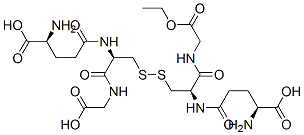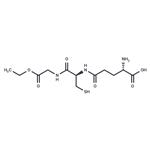Glutathione (GSH) serves as a nucleophilic co-substrate to glutathione transferase in the detoxification of xenobiotics and is an essential electron donor to glutathione peroxidases in the reduction of hydroperoxides. GSH ethyl ester is a cell-permeable derivative of GSH that undergoes hydrolysis by intracellular esterases to release GSH. Effective transport of GSH ethyl ester has been used to protect cells against damage from radiation, oxidants, and various toxic compounds including heavy metals.
Glutathione (GSH) serves as a nucleophilic co-substrate to glutathione transferase in the detoxification of xenobiotics and is an essential electron donor to glutathione peroxidases in the reduction of hydroperoxides. GSH ethyl ester is a cell permeable derivative of GSH that undergoes hydrolysis by intracellular esterases to release GSH. Effective transport of GSH ethyl ester has been used to protect cells against damage from radiation, oxidants, and various toxic compounds including heavy metals.
Glutathione reduced ethyl ester has been used:
- to increase intracellular glutathione levels in mouse fibroblast L929 cells
- as a medium supplement in Spodoptera frugiperda (Sf)9 cells
- to evaluate its effect on lipid peroxidation after spinal cord injury
Glutathione reduced ethyl ester (GSH-MEE) is a membrane/lipid permeable derivative of GSH that may be used to partially supplement the GSH supply within cells subjected to cysteine and/or GSH depletion. GSH-MEE is hydrolysed by intracellular esterases to release GSH, thereby increases the concentrations of intracellular GSH. It prevents the toxic effects of acetaminophen in animal cells. It protects human lymphoid cells and skin fibroblasts against the damage caused due to radiation.


